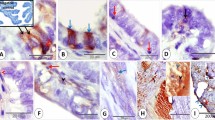Summary
Cells of the cervicovaginal epithelium of neonatal mice underwent morphological changes in response to estradiol injection. On the luminal border, estradiol treatment caused development of distinct microvilli and a prominent surface coat of delicate filamentous material. Very deep nuclear folds appeared, and the border between adjacent cells became strongly interdigitated. The cells developed a pronounced smooth and rough endoplasmic reticulum, and dark-stained membrane-bounded granules accumulated in the apical part of the cells.
Estradiol promoted increased production of an antigenic material specific for the cervicovaginal epithelium (CVA). Immunofluorescence studies demonstrated CVA in the most apical part of the cells, in the extracellular material on the epithelial surface, and in the intercellular spaces between adjacent epithelial cells. This was confirmed by immunoferritin methods, which revealed that the antigen was localized to the surface coat and to material adhering closely to the exterior of the cell membrane, the part facing the lumen and also the part facing intercellular spaces. Within the cells, ferritin tagging was recognized around the membranes enclosing the dark-stained granules in the apical part of the cells and also on the inside of the luminal cell membrane. This is so interpreted that CVA acquires its antigenic properties when passing out from the dark-stained granules through the surrounding envelope. CVA apparently forms part of the glycocalyx of the cervicovaginal cells.
Similar content being viewed by others
References
Alexander, P.: Foetal “antigens” in cancer. Nature (Lond.) 235, 137–140 (1972).
Ballard, P. L., Tomkins, G. M.: Glucocorticoid-induced alteration of the surface membrane of cultured hepatoma cells. J. Cell Biol. 47, 222–234 (1970).
Bennett, H. S.: Morphological aspects of extracellular polysaccharides. J. Histochem. Cytochem. 11, 14–23 (1963).
Dorfman, A.: The production of protoglycans in normal and pathological conditions. In: E. A. Balazs (ed.), Chemistry and molecular biology of the intercellular matrix, vol. 3, p. 1421–1513. London: Academic Press 1970.
Forsberg, J.-G., Kvinnsland, S.: The appearance and distribution of vaginal antigen during the differentiation of the cervicovaginal epithelium in normal and estradiol-treated mice. J. exp. Zool. 180, 403–412 (1972).
Forsberg, J.-G., Nord, L.: Immunofluorescence studies on the distribution of mouse uterine epithelial antigen in foetal, immature and adult mice. J. Embryol. exp. Morph. 21, 85–95 (1969).
Forsberg, J.-G., Olivecrona, H.: Further studies on the differentiation of the epithelium in the mouse vaginal anlage. Z. Zellforsch. 66, 867–877 (1965).
Gold, P., Gold, M., Freedman, S. O.: Cellular location of carcinoembryonic antigens of the human digestive system. Cancer Res. 28, 1331–1334 (1968).
Gregoire, A. T., Kandil, O., Ledger, W. J.: The glycogen content of human vaginal epithelial tissue. Fertil. and Steril. 22, 64–68 (1971).
Luft, J. H.: Ruthenium red and violet. I. Chemistry, purification, methods of use for electron microscopy and mechanism of action. Anat. Rec. 171, 347–368 (1971a).
Luft, J. H.: Ruthenium red and violet. II. Fine structural localization in animal tissues. Anat. Rec. 171, 369–416 (1971b).
Millonig, G.: Further observations on a phosphate buffer for osmium solution in fixation. In: S. Breese (ed.), Electron microscopy, vol. 2, p. 8. New York: Academic Press 1962.
Morgan, C., Rifkind, R. A., Hsu, K. C., Holden, M., Seegal, B. C., Rose, H. M.: Electron microscopic localization of intracellular viral antigen by the use of ferritin-conjugated antibody. Virology 14, 292–309 (1961).
Nilsson, O.: Ultrastructure of mouse uterine surface epithelium under different estrogenic influences. I. Spayed animals and oestrous animals. J. Ultrastruct. Res. 1, 375–396 (1958a).
Nilsson, O.: Ultrastructure of mouse uterine surface epithelium under different estrogenic influences. III. Late effect of estrogen administered to spayed animals. J. Ultrastruct. Res. 2, 185–199 (1958b).
Parakkal, P. F., Gregoire, A. T.: Differentiation of vaginal epithelium in the normal and hormone-treated Rhesus monkey. Biology of Reproduction 6, 117–130 (1972).
Reynolds, E. S.: The use of lead citrate at high pH as an electron-opaque stain in electron microscopy. J. Cell Biol. 17, 208–212 (1963).
Singer, S. J.: Preparation of an electron-dense antibody conjugate. Nature (Lond.) 183, 1523 (1959).
Sri Ram, J., Tawde, S. S., Pierce, G. B., jr., Midgley, A. R., jr.: Preparation of antibody-ferritin conjugates for immune-electron microscopy. J. Cell Biol. 17, 673–675 (1963).
Terzakis, J. A.: The nucleolar channel system of human endometrium. J. Cell Biol. 27, 293–304 (1965).
Author information
Authors and Affiliations
Additional information
This investigation was supported by grants from the Norwegian Cancer Society (Landsforeningen mot Kreft) and the Norwegian Research Council.
Rights and permissions
About this article
Cite this article
Åbro, A., Kvinnsland, S. Immunocytological studies on an estradiol sensitive antigen in the cervicovaginal epithelium of neonatal mice. Z.Zellforsch 133, 559–569 (1972). https://doi.org/10.1007/BF00307136
Received:
Issue Date:
DOI: https://doi.org/10.1007/BF00307136




